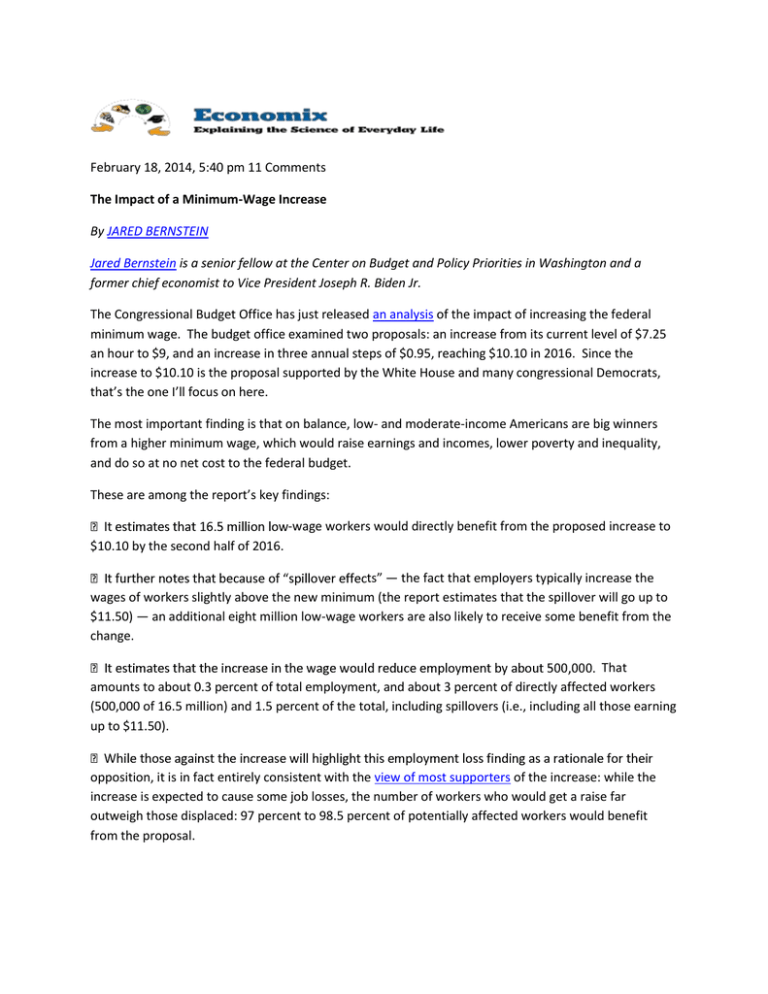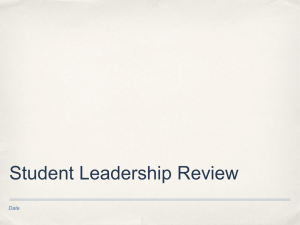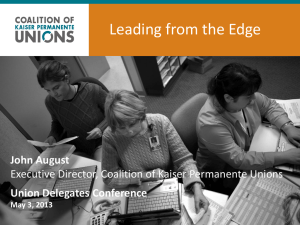February 18, 2014, 5:40 pm 11 Comments ed
advertisement

February 18, 2014, 5:40 pm 11 Comments The Impact of a Minimum-Wage Increase By JARED BERNSTEIN Jared Bernstein is a senior fellow at the Center on Budget and Policy Priorities in Washington and a former chief economist to Vice President Joseph R. Biden Jr. The Congressional Budget Office has just released an analysis of the impact of increasing the federal minimum wage. The budget office examined two proposals: an increase from its current level of $7.25 an hour to $9, and an increase in three annual steps of $0.95, reaching $10.10 in 2016. Since the increase to $10.10 is the proposal supported by the White House and many congressional Democrats, that’s the one I’ll focus on here. The most important finding is that on balance, low- and moderate-income Americans are big winners from a higher minimum wage, which would raise earnings and incomes, lower poverty and inequality, and do so at no net cost to the federal budget. These are among the report’s key findings: -wage workers would directly benefit from the proposed increase to $10.10 by the second half of 2016. ts” — the fact that employers typically increase the wages of workers slightly above the new minimum (the report estimates that the spillover will go up to $11.50) — an additional eight million low-wage workers are also likely to receive some benefit from the change. That amounts to about 0.3 percent of total employment, and about 3 percent of directly affected workers (500,000 of 16.5 million) and 1.5 percent of the total, including spillovers (i.e., including all those earning up to $11.50). opposition, it is in fact entirely consistent with the view of most supporters of the increase: while the increase is expected to cause some job losses, the number of workers who would get a raise far outweigh those displaced: 97 percent to 98.5 percent of potentially affected workers would benefit from the proposal. budget office estimates that because of the increase, 900,000 who are currently poor would move above the poverty threshold. That’s about 2 percent of the number it expects to be poor when the increase is phased in (45 million). s, 88 percent are adult (20 and older), 56 percent are female, and most work full time (i.e., 53 percent work 35 or more hours a week). -wage workers will increase under the proposal. About 70 percent of low-wage workers live in families whose average incomes are projected to rise, from 2.8 percent for the poorest families to 0.4 percent for middle-income families. .4 percent, or $700 for a family with average income around $180,000. This results from reduced profits for business owners and slightly increased prices of goods and services that are not offset for these families by the higher wage. Note that these income predictions imply slightly lower income inequality. A few comments about these findings: To derive the job-loss effects, the report does not do any original research. It just uses estimates from a wide range of studies on the impact of past minimum-wage increases. (For the technically inclined, it applies a negative employment elasticity that reflects the percent decline in jobs given a percent increase in the minimum wage.) It is important to recognize that there is a very wide range of estimates from which the budget agency can choose, as shown in the chart below, which plots results of the employment effect from dozens of studies (from a recent set of slides from the White House Council of Economic Advisers). This wide range does not imply that the budget office made a mistake, though it looks to me as if it applied a higher job-loss estimate than is the current consensus among economists who’ve closely studied the issue. Note: “se” refers to standard error; 1/se is a measure of statistical significance. Source: Doucouliagos and Stanley (2009); data provided by John Schmitt. As the chart shows, the employment impact from this “meta-analysis” clumps around zero, which is why the report finds that the policy is a significant net plus from the perspective of low-wage workers: Many more workers get a raise from the policy than are displaced from their jobs. In fact, the study points out that the range, or confidence interval, around their central estimate ranges from a “very slight decrease” to one million. The authors guess that there’s a two-thirds chance that the true estimate is in that range. There is no policy I can think of that generates only benefits without any costs, and policy makers always have to weigh the two sides. In the case of the minimum wage, on the benefits side of ledger, the budget office shows that 16.5 million low-wage workers would directly get a much-needed pay increase at no cost to the federal budget. Though the budget agency did not analyze longer-term results for these workers, it’s also the case that when those displaced by the increase get their next low-wage job, they too will benefit from a higher paycheck than would otherwise be the case. As I’ve stressed many times on this blog, policy makers need to be concerned about the quantity of jobs, and pursue policies that will increase that number. But they also have to worry about job quality, especially in the low-wage sector, where the decline in the real value of the minimum wage, the increase in earnings inequality (meaning less growth finds its way to the low end of the wage scale), and the low bargaining power of the work force have placed strong, negative pressure on wage trends for decades. With such job-quality concerns in mind, I’d say the long history of research shows that increasing the minimum wage is a simple, effective policy that achieves its goal of raising the value of low-wage work with minimal distortions at no cost to the federal budget. The Congressional Budget Office report further confirms that conclusion.



